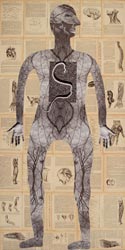September 6 - October 11, 2014
Reception: September 6, 2014 5-7PM
Just as there are multiple layers of paint and photography in Holly Roberts’ work, there are also complex narrative strata drawn from the artists personal stories, world religions, and the cultural history of the American Southwest. In the 80s and 90s, Roberts became recognized for hauntingly dark painted photographs with an inner glow that appeared to emanate from obscured silver prints within. Then ten years ago, like the ancient Greek vase painters who reversed from black to red figures to gain expressive opportunity, she began collaging her photographic elements onto painted surfaces. Her animals and figures are now formed with cut-out photos of trees, dried mud, Navajo blankets, snakeskins, newsprint, nests and eyes in quirky and suggestive combinations. Roberts is part of the tradition of artists throughout the ages who have re-interpreted classical mythologies and religious parables to tell their own stories, or bring contemporary resonance to timeless tales. From the upcoming exhibition, a new work entitled Adam’s Rib, utilizes a grid of pages from Gray’s Anatomy as background, reminding us that Eve’s body, as the title suggests, was composed of one of these anatomical “parts.” In this collage however, her body is constructed of vines that take the shape of ovaries and her head is made of Sandhill Cranes, while a dead snake emblazoned on her chest like the letter “S” for sinner, recalls The Scarlet Letter’s “A” for adultery. Although Roberts has been collected and exhibited widely for 30 years, the exhibition at Craig Krull Gallery will be her first solo show in the LA area.
Often quoted in relation to exhibitions at Craig Krull Gallery is the poet Gary Snyder, who said, “Our place is part of what we are.” Usually we refer to this idea in terms of an artist’s response to place, but in the work of James Griffith, even the physical material of his paintings is part of what we are. In his first exhibit at our gallery, Griffith will present a series of artworks painted with tar, collected directly from the La Brea Tar Pits. As the artist notes, “Tar is a primordial substance that suggests the enduring cycles of evolution and extinction. It is also a petrochemical fuel at the heart of our contemporary ecological crisis.” This oozing, viscous matter, which trapped and preserved the bodies of ancient animals, is employed by Griffith to depict the animals of our own age such as deer, cougars, and pelicans. Griffith states, “My painting process involves contrasting the uncontrolled fluid qualities of tar with precise rendering and minute detail of individual animals. I see painting about Nature as a way of asking the fundamental questions about life, ‘Who are we?’ and ‘How did we get here?’ ”

